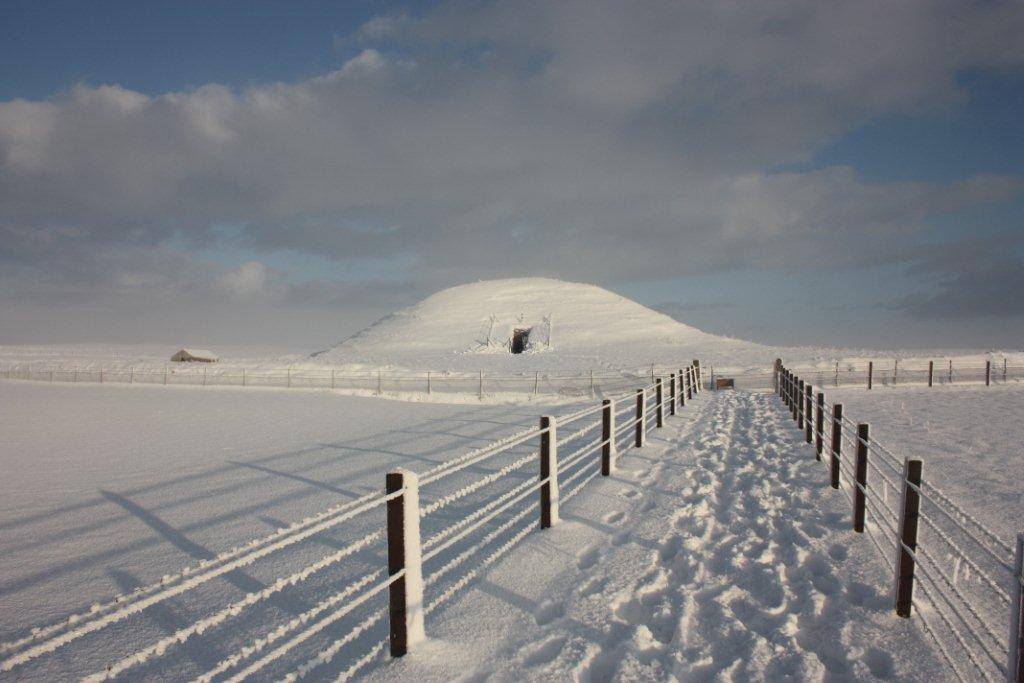To many people in Scotland, the Winter Solstice is more commonly known as ‘the shortest day’, and marks the point of the year when those dark nights start to get a little less dark, one night at a time.
Our ancestors felt this much more keenly than we do today. Being governed by the seasons, and relying on the land, the Winter Solstice was hugely significant. To them, Midwinter (as it is also known) was a turning point; light and warmth were on their way back.
So join us on this shortest day, as we take a look at some of Scotland’s prehistoric places most associated with the Winter Solstice.

An aerial view of the Maeshowe Chambered Cairn mound and surrounding earth wall.
What is the Winter Solstice?
The Earth rotates on an axis that is tilted, and when it tilts the Northern Hemisphere away from the sun we have winter (and the Southern Hemisphere has summer). The Winter Solstice is the moment when the sun is at its lowest in the sky, giving us the fewest daylight hours of the year.
According to the Royal Observatory at Greenwich, the actual moment of the solstice in the UK this year will occur on Friday 22 December at 3.27am GMT, although the term Winter Solstice is more typically used to refer to the actual day on which that moment occurs.
And yes, it’s not always on 21 December. Every fourth year it bumps into the early hours of the next day, due to the Earth taking 365.25 days to orbit the Sun and our Gregorian calendar having only 365 days in it (a leap Solstice?).
So let’s take a look at people who used very different types of calendars, and how the Winter Solstice affected them. And in Scotland, there’s really only one place you can begin.

Setting midwinter sun illuminating the entrance passage during the Winter Solstice, Maeshowe Chambered Cairn.
Maeshowe Chambered Cairn
About ten miles west of Kirkwall, you’ll find what looks like a large, grassy mound in the middle of a field, surrounded by hills. Unlike most grassy mounds, this one has an entrance. And that entrance is the key to the magic of Orkney’s Maeshowe Chambered Cairn.
For around six weeks in the winter, the setting sun aligns with the central chamber, glowing through the door, along the 15 metre passageway and illuminating the tomb. On the Solstice itself, the rays of the setting sun play across the rear wall of the chamber.
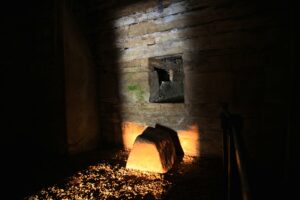
Setting midwinter sun casting a ray of light onto the stone block at the back wall of the tomb at Maeshowe Chambered Cairn, during the Winter Solstice.
This alignment suggests that the Neolithic community who built this monument had beliefs that focused upon key points within the solar calendar. The degree of planning that would have gone into Maeshowe is unfathomable to us today.
It has been suggested that the setting of the Midwinter sun marks the death of the previous year and the start of a new, or rebirth. The alignment at Maeshowe is perhaps illustrative of Neolithic society’s beliefs relating to cycles of life and death and the afterlife.
Last year we visited Maeshowe and celebrated the Winter Solstice with stories and poetry from the site, as you can see from the video below!
The Wren’s Egg
Maeshowe is of vital importance as its Solstice links can be seen clearly today. At other sites, that connection has to be implied, and an example of this can be found in the rolling Machars countryside of Galloway, just north of the village of Monreith.
There you’ll find an enormous glacial boulder, 2m in height and 7m in diameter, with a pair of granite standing stones a short walk away. This is the Wren’s Egg (the reason for the name having been lost to time, although it was likely given tongue in cheek).
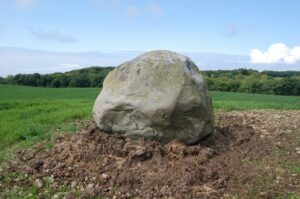
The large glacial boulder known as the ‘wren’s egg’ in Dumfries and Galloway.
Pairs of standing stones have not been given the intense study of more dramatic stone circles, but they date to the Bronze Age and usually one of the stones is shorter and more triangular than the other.
The Wren’s Egg was included by Professor Alexander Thom in his hugely comprehensive mathematical investigation of megalithic sites in Britain. Thom believed the alignment was with the setting sun on the Midwinter solstice.
Although the Egg itself has been moved, the two stones could have been aligned with the movements of the moon and sun, in a ‘shadow union’ relating to different times of year, including Midwinter.
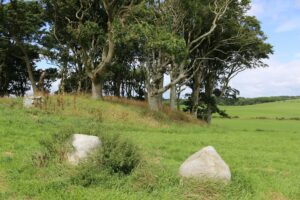
The paired standing stones at the Wren’s Egg in Dumfries and Galloway. The boulder is directly behind the photographer; the small copse is known informally as ‘the wren’s nest’
Clava Cairns
A similar hypothesis has been suggested for shadows cast at the Bronze Age Clava Cairns, one of Scotland’s most evocative prehistoric sites. Set on a terrace above the River Nairn just outside Inverness, these burial sites are about 4,000 years old.
The cemetery at Balnuaran of Clava is particularly well-preserved, and consists of circular cairns with a surrounding platform and ring of standing stones. Investigations by archaeologist Richard Bradley and others have demonstrated that the placement of stones of different colours appears deliberate.
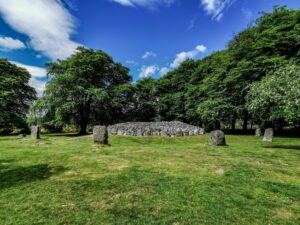
General view of the Balnuaran of Clava cairn and associated standing stones. This is one of three well-preserved cairns in the area.
The careful arrangement of red and pink sandstone to the southwest of the circle appear to glow red at Midwinter, and lighter stones run through with quartz at the northeast sparkle in the light of the rising sun at Midsummer.
This underlines that seasonal events were of great importance to the people of the time, but it also suggests that they were intended to create a dramatic visual effect at key points of the year. These sites were to be visited and experienced; the experience was not solely reserved for those interred in the central chamber.

One of the reddish standing stones at the Balnuaran of Clava standing circle.
The symbolism of the Solstice
Evidence from these sites and others strongly suggests that Neolithic monuments were important places for ceremonial gatherings and ritual activity. The cycles of the changing seasons were all-important.
Indeed, Bradley’s work has revealed a suggestion that these funerary monuments were oriented towards the ‘dark side of the sky’, indicating associations with sunset and the world of the dead (roundhouses being typically oriented towards the rising sun and the world of the living).
The shortest day of the year is far more than a quirk of the calendar. For the people of thousands of years ago, it was literally about life and death.
This blog post is a partner to a previous post about the Summer Solstice in Scotland. If you’re out and about for the Winter Solstice this year, we’d love to see your photos! You’re always welcome to share snaps of your historic adventures on our Historic Scotland social media channels. Find us on Instagram, Facebook and Twitter.

